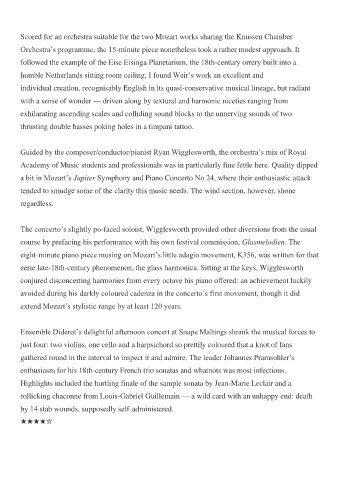Page 541 - Media Coverage Book - 75th Aldeburgh Festival 2024
P. 541
Scored for an orchestra suitable for the two Mozart works sharing the Knussen Chamber
Orchestra’s programme, the 15-minute piece nonetheless took a rather modest approach. It
followed the example of the Eise Eisinga Planetarium, the 18th-century orrery built into a
humble Netherlands sitting room ceiling. I found Weir’s work an excellent and
individual creation, recognisably English in its quasi-conservative musical lineage, but radiant
with a sense of wonder — driven along by textural and harmonic niceties ranging from
exhilarating ascending scales and colliding sound blocks to the unnerving sounds of two
thrusting double basses poking holes in a timpani tattoo.
Guided by the composer/conductor/pianist Ryan Wigglesworth, the orchestra’s mix of Royal
Academy of Music students and professionals was in particularly fine fettle here. Quality dipped
a bit in Mozart’s Jupiter Symphony and Piano Concerto No 24, where their enthusiastic attack
tended to smudge some of the clarity this music needs. The wind section, however, shone
regardless.
The concerto’s slightly po-faced soloist, Wigglesworth provided other diversions from the usual
course by prefacing his performance with his own festival commission, Glasmelodien. The
eight-minute piano piece musing on Mozart’s little adagio movement, K356, was written for that
eerie late-18th-century phenomenon, the glass harmonica. Sitting at the keys, Wigglesworth
conjured disconcerting harmonies from every octave his piano offered: an achievement luckily
avoided during his darkly coloured cadenza in the concerto’s first movement, though it did
extend Mozart’s stylistic range by at least 120 years.
Ensemble Diderot’s delightful afternoon concert at Snape Maltings shrank the musical forces to
just four: two violins, one cello and a harpsichord so prettily coloured that a knot of fans
gathered round in the interval to inspect it and admire. The leader Johannes Pramsohler’s
enthusiasm for his 18th-century French trio sonatas and whatnots was most infectious.
Highlights included the hurtling finale of the sample sonata by Jean-Marie Leclair and a
rollicking chaconne from Louis-Gabriel Guillemain — a wild card with an unhappy end: death
by 14 stab wounds, supposedly self-administered.
★★★★☆

